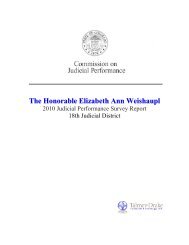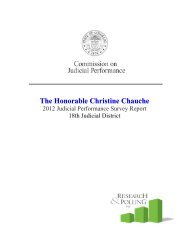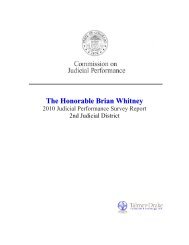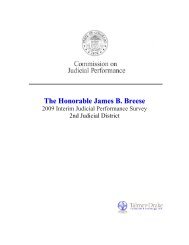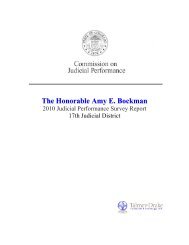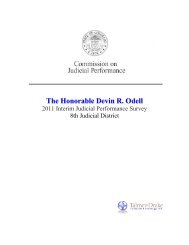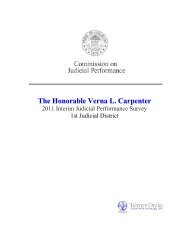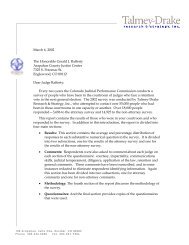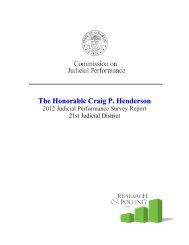The Honorable Daniel J. Kaup - Mountain Legal â Colorado ...
The Honorable Daniel J. Kaup - Mountain Legal â Colorado ...
The Honorable Daniel J. Kaup - Mountain Legal â Colorado ...
Create successful ePaper yourself
Turn your PDF publications into a flip-book with our unique Google optimized e-Paper software.
ii. In 2009 the Attorneys Regarding Trial Judges Survey moved from being a papersurvey mailed to potential respondents to an online survey. Moving the survey toonline permitted asking individual attorneys to evaluate up to five trial judges, and withthe exception of the effects of the modified assignment rules 1 through 3 below, itbecame a survey of all attorneys who had cases before trial judges. Allowing anattorney to evaluate up to five judges, entailed slightly modifying the assignment rules:1. No attorney would be asked to evaluate the same justice or judge in a 24-monthperiod.2. If an attorney was eligible to evaluate both a trial judge and an appellate judge,the attorney was assigned to evaluate the appellate judge.3. If there were more than five judges who could be assigned to the attorney, theattorney was assigned the judges with whom he or she had had the most casesduring the sampling time frame, or the judges with the smallest samples in orderto even out sample sizes among judges.Attorneys were first mailed a letter about the online survey to let them know that theywould soon receive an email with a link to the survey. <strong>The</strong> Web address of the surveyand a password were included in the letter if the attorney wanted to complete thesurvey immediately. A week after the first email was sent, a follow-up email was sent.Potential respondents who did not complete the survey after the second email were thentelephoned and asked to either complete the survey then by phone, or to pleasecomplete it online.iii. In 2010 rule #2 above was changed so that an attorney could be asked to evaluatea combination of up to seven trial judges or Court of Appeals judges, if the attorney hadhad a case before the COA. Attorneys who had cases before the both the Supreme Courtand trial judges during the sample time frame were asked to evaluate all seven SupremeCourt justices, and not asked to evaluate the trial judges.<strong>The</strong> results shown in the 2010 Judicial Performance Survey Report for the AttorneysRegarding Trial Judges survey are based on the combined data collected from January2005 through early February 2010 1 for those questions that have been consistently askedduring that time period.Starting in 2010, the Judicial Performance Survey reports are based on a movingaverage, or rolling sample, of data collected over a period of time equal to the justice’s orjudge’s term of office: ten years for a Supreme Court justice, eight years for a COAjudge, six years for a district judge and four years for a county judge. To use a districtjudge as an example: as survey data is collected it is pooled together for six years. Aftersix years, as new data is added to the judge’s survey results in the first quarter of theseventh year, the oldest quarter of data in the pool is deleted.<strong>The</strong> current data for all judges only goes back as far as 2005—or the year the judge tookthe bench—therefore the rolling of the data only affects the county judge sample in the2010 reports.1 <strong>The</strong> State Commission on Judicial Performance authorized continuous surveying in 2007. Prior to 2007 data wasonly collected in the odd numbered years before the retention reports were issued. <strong>The</strong>refore, while data wasgathered in 2005, 2007, 2008 and 2009, and used in this report, there was no data collected in 2006.2010 Judicial Performance Survey Report19



